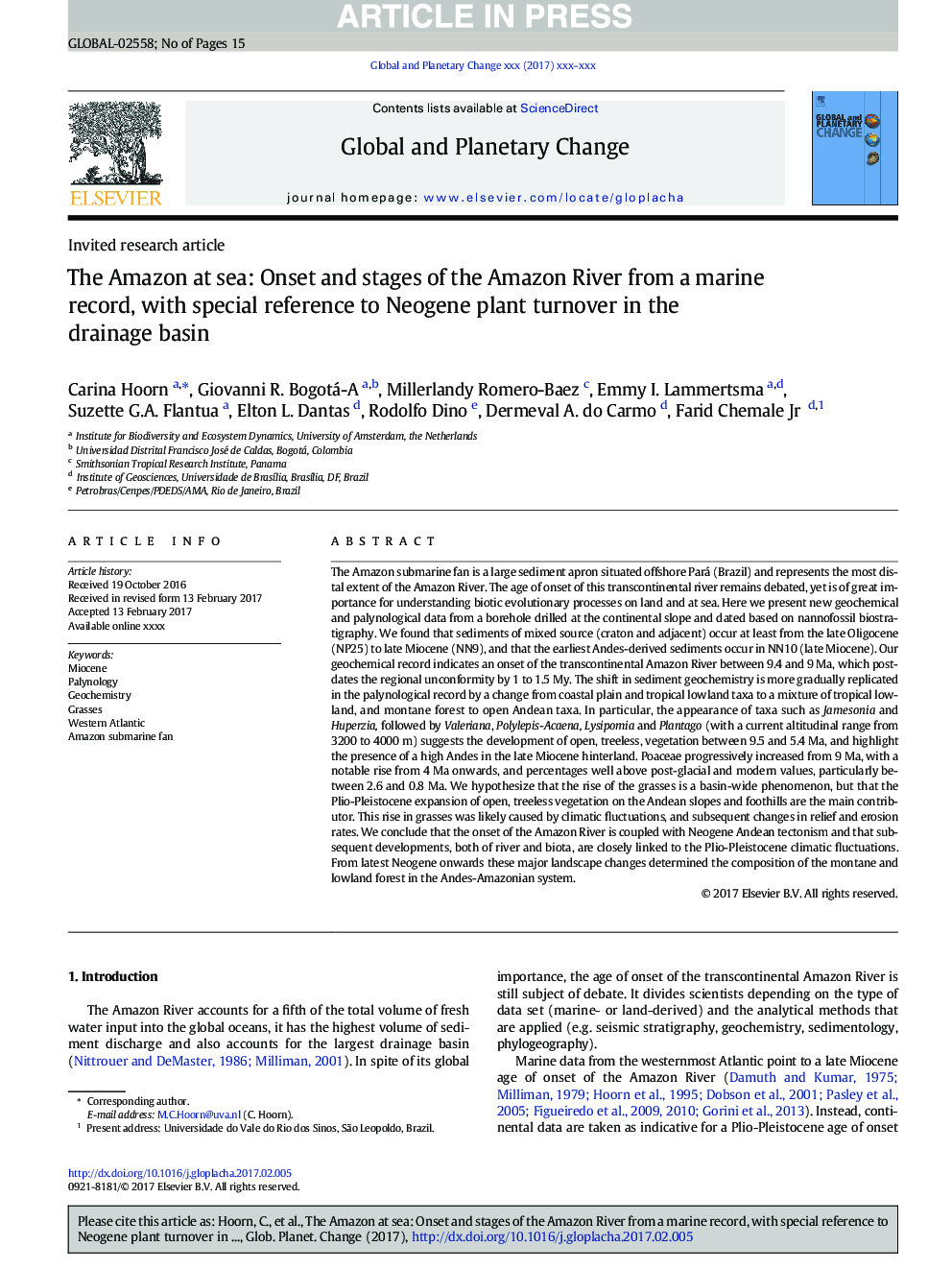| کد مقاله | کد نشریه | سال انتشار | مقاله انگلیسی | نسخه تمام متن |
|---|---|---|---|---|
| 5755378 | 1621629 | 2017 | 15 صفحه PDF | دانلود رایگان |
عنوان انگلیسی مقاله ISI
The Amazon at sea: Onset and stages of the Amazon River from a marine record, with special reference to Neogene plant turnover in the drainage basin
ترجمه فارسی عنوان
آمازون در دریای: آغاز و مراحل رودخانه آمازون از رکورد دریایی، با اشاره ویژه به گردش گیاه نئوژن در حوضه زهکشی
دانلود مقاله + سفارش ترجمه
دانلود مقاله ISI انگلیسی
رایگان برای ایرانیان
کلمات کلیدی
میوسن، پالینولوژی، ژئوشیمی، چمنزارها، اقیانوس اطلس، طرفداران زیردریایی آمازون،
موضوعات مرتبط
مهندسی و علوم پایه
علوم زمین و سیارات
فرآیندهای سطح زمین
چکیده انگلیسی
The Amazon submarine fan is a large sediment apron situated offshore Pará (Brazil) and represents the most distal extent of the Amazon River. The age of onset of this transcontinental river remains debated, yet is of great importance for understanding biotic evolutionary processes on land and at sea. Here we present new geochemical and palynological data from a borehole drilled at the continental slope and dated based on nannofossil biostratigraphy. We found that sediments of mixed source (craton and adjacent) occur at least from the late Oligocene (NP25) to late Miocene (NN9), and that the earliest Andes-derived sediments occur in NN10 (late Miocene). Our geochemical record indicates an onset of the transcontinental Amazon River between 9.4 and 9Â Ma, which postdates the regional unconformity by 1 to 1.5Â My. The shift in sediment geochemistry is more gradually replicated in the palynological record by a change from coastal plain and tropical lowland taxa to a mixture of tropical lowland, and montane forest to open Andean taxa. In particular, the appearance of taxa such as Jamesonia and Huperzia, followed by Valeriana, Polylepis-Acaena, Lysipomia and Plantago (with a current altitudinal range from 3200 to 4000Â m) suggests the development of open, treeless, vegetation between 9.5 and 5.4Â Ma, and highlight the presence of a high Andes in the late Miocene hinterland. Poaceae progressively increased from 9Â Ma, with a notable rise from 4Â Ma onwards, and percentages well above post-glacial and modern values, particularly between 2.6 and 0.8Â Ma. We hypothesize that the rise of the grasses is a basin-wide phenomenon, but that the Plio-Pleistocene expansion of open, treeless vegetation on the Andean slopes and foothills are the main contributor. This rise in grasses was likely caused by climatic fluctuations, and subsequent changes in relief and erosion rates. We conclude that the onset of the Amazon River is coupled with Neogene Andean tectonism and that subsequent developments, both of river and biota, are closely linked to the Plio-Pleistocene climatic fluctuations. From latest Neogene onwards these major landscape changes determined the composition of the montane and lowland forest in the Andes-Amazonian system.
ناشر
Database: Elsevier - ScienceDirect (ساینس دایرکت)
Journal: Global and Planetary Change - Volume 153, June 2017, Pages 51-65
Journal: Global and Planetary Change - Volume 153, June 2017, Pages 51-65
نویسندگان
Carina Hoorn, Giovanni R. Bogotá-A, Millerlandy Romero-Baez, Emmy I. Lammertsma, Suzette G.A. Flantua, Elton L. Dantas, Rodolfo Dino, Dermeval A. do Carmo, Farid Jr,
